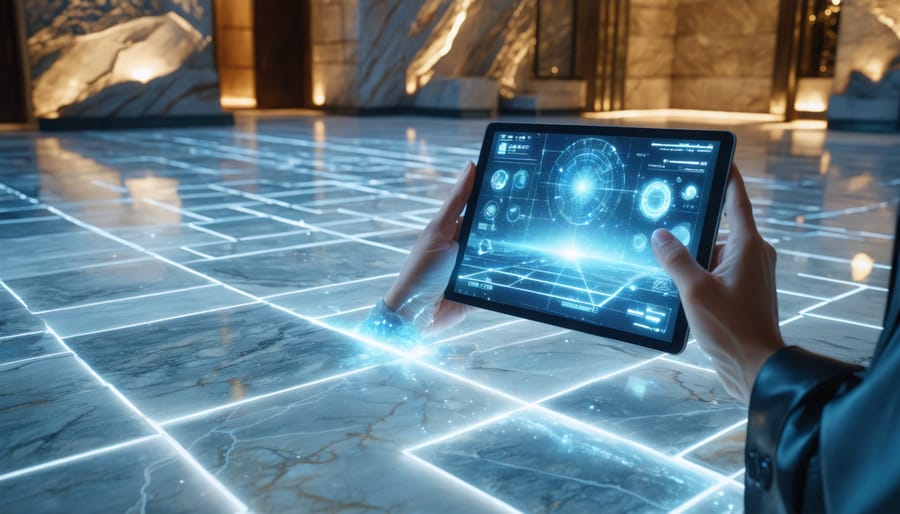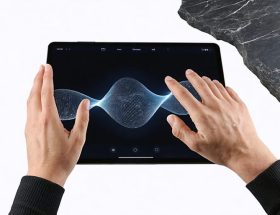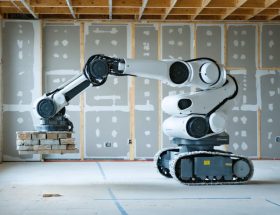Step into the future of architectural design with augmented reality (AR) floors – a groundbreaking technology that’s revolutionizing stone architecture and interior visualization. This innovative solution projects hyper-realistic stone patterns onto existing surfaces, allowing designers and homeowners to instantly preview different materials, patterns, and layouts before making permanent decisions. By merging digital precision with physical spaces, AR floor technology eliminates the guesswork from stone selection, reduces costly mistakes, and transforms the way we experience design possibilities. Whether you’re a professional architect planning a large-scale installation or a homeowner renovating your space, this cutting-edge tool offers unprecedented accuracy and creative freedom in visualizing natural stone applications. The technology’s ability to render textures, veining, and color variations in real-time has made it an indispensable asset in modern architectural planning and design consultation.
What is an Augmented Reality Floor System?
Key Components of AR Floor Systems
AR floor systems rely on several essential components working in harmony to create immersive experiences. The foundation begins with high-resolution cameras and sensors that accurately capture the physical space and track movement in real-time. These are typically mounted overhead or integrated into the flooring system itself.
Projection systems form another crucial element, using advanced display technology to overlay digital content onto the floor surface. These projectors must deliver bright, clear images even in varying lighting conditions, with some systems incorporating multiple units for seamless coverage of larger areas.
The software component includes sophisticated tracking algorithms and rendering engines that process spatial data and generate responsive visuals. This is paired with calibration tools that ensure precise alignment between the physical floor and projected content.
A robust computing system serves as the brain of the operation, processing inputs and managing content delivery with minimal latency. Many modern systems also include network connectivity for remote management and content updates.
For stone and tile applications specifically, these systems often incorporate material-scanning capabilities to accurately represent texture, color, and pattern variations in virtual overlays.
How AR Floor Technology Works
AR floor technology combines advanced computer vision, motion tracking, and real-time rendering to create an interactive visualization layer over physical flooring surfaces. The system typically consists of three main components: cameras or sensors, processing software, and display devices.
High-resolution cameras mounted strategically in the space capture the existing floor surface, while sophisticated stone mapping technology analyzes the space’s dimensions and characteristics. The processing software then creates a digital mesh that precisely matches the physical environment’s contours and lighting conditions.
When users interact with the AR system through a tablet, smartphone, or specialized headset, the software overlays photorealistic digital stone patterns onto the existing floor surface in real-time. Advanced algorithms ensure the virtual materials maintain proper perspective, scale, and lighting as viewers move through the space, creating a convincing illusion of installed stone flooring.
The technology also accounts for room features like walls, columns, and fixed furniture, automatically adjusting the virtual stone pattern to flow naturally around these elements. This creates a seamless visualization that helps designers and clients accurately preview how different stone options will look in the actual space before making final material selections.
Modern AR floor systems can now handle complex stone patterns, veining, and natural variations, providing an unprecedented level of realism in digital visualization for natural stone applications.
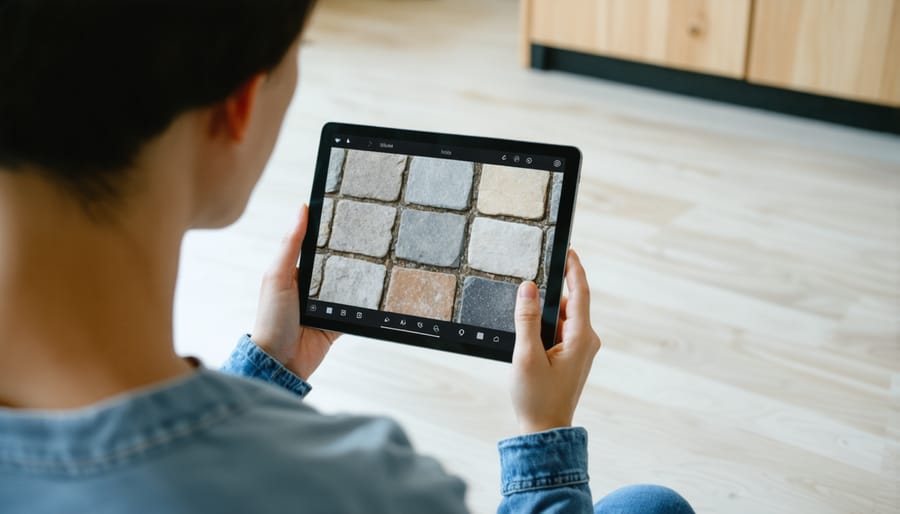
Benefits for Stone Design Visualization
Real-time Pattern and Layout Preview
AR floor technology revolutionizes the stone selection process by providing instant, true-to-life previews of different patterns and layouts in your actual space. Using sophisticated AI-powered design solutions, these systems can accurately render various stone options, showing precise coloring, veining patterns, and texture details in real-time.
As you move through the space with your mobile device or AR glasses, the technology maintains proper perspective and scaling, allowing you to view the stone layout from different angles and distances. This immediate visualization helps identify potential pattern mismatches, bookmatching opportunities, and optimal tile arrangements before any physical installation begins.
The system can instantly switch between different stone varieties, finishes, and layout patterns, making it easier to compare options side by side in your actual environment. This capability is particularly valuable when working with luxury stones like marble or onyx, where pattern flow and continuity are crucial to the final aesthetic impact.
For designers and homeowners alike, this real-time preview functionality significantly reduces the risk of costly design mistakes and ensures complete satisfaction with the final selection.
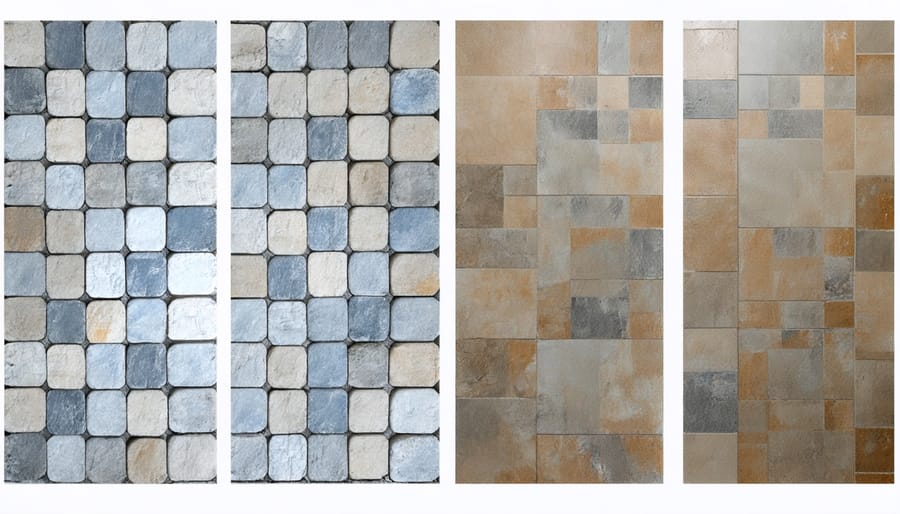
Cost and Time Savings
Implementing AR floor technology offers significant financial advantages across multiple aspects of stone selection and installation. By allowing virtual visualization of different stone options, businesses can drastically reduce sample costs and minimize waste from incorrect material choices. Traditional sampling methods often require multiple physical samples, shipping costs, and time-consuming exchanges, which can add up to substantial expenses.
The technology streamlines the decision-making process, reducing the average project timeline by 30-40%. Clients can instantly view multiple stone variations in their space, eliminating the need for repeated site visits and physical mock-ups. This efficiency translates to reduced labor costs and faster project completion rates.
For stone suppliers and showrooms, AR floors decrease inventory carrying costs as fewer physical samples need to be maintained. The technology also reduces the likelihood of returns and replacements due to visualization mismatches, resulting in fewer material losses and installation corrections.
Real estate professionals report closing deals faster when using AR floor technology, as clients can make confident decisions more quickly, reducing the sales cycle and associated costs.
Practical Applications in Stone Design
Commercial Projects
Retailers and office spaces are increasingly adopting augmented reality floors to create immersive shopping experiences and dynamic work environments. Major retail chains have implemented interactive floor displays that guide customers through stores, showcase product information, and create engaging promotional zones. Luxury boutiques use AR flooring to transform spaces instantly, allowing customers to visualize different stone patterns and materials in real-time.
In corporate settings, AR floors facilitate wayfinding in large office complexes and create adaptable meeting spaces. Companies like Google and Microsoft have integrated these systems in their innovation centers, where floor displays can switch between presentation modes, collaborative workspaces, and interactive demonstrations. Shopping malls utilize AR floor technology for advertising, creating seasonal displays, and providing interactive directories that respond to foot traffic.
Notable implementations include Bloomingdale’s virtual runway experience and Samsung’s digital showroom, where AR floors seamlessly blend with traditional stone flooring to create stunning visual displays while maintaining the elegance of natural materials.
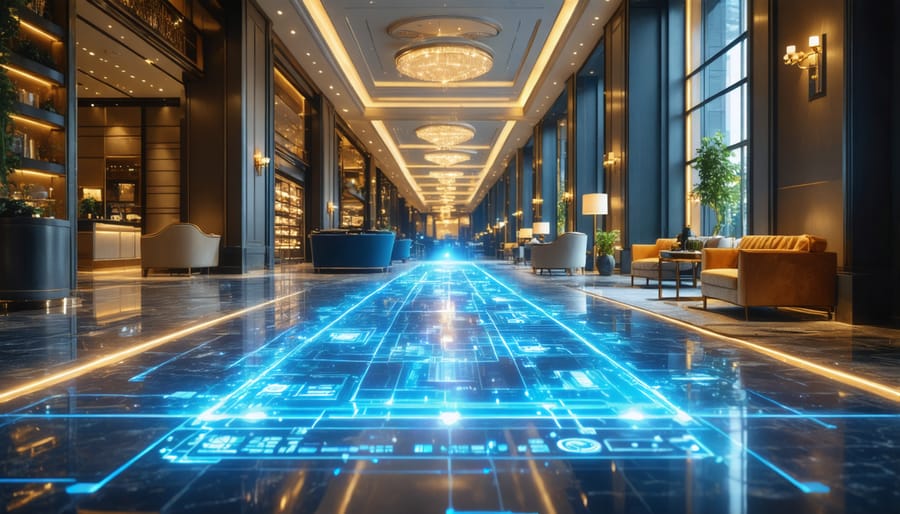
Residential Applications
Augmented reality flooring technology is revolutionizing home renovation projects by allowing homeowners to visualize different stone and tile options in their actual living spaces. Through mobile apps and smart devices, residents can preview various natural stone patterns, colors, and layouts before making final decisions. This technology proves particularly valuable when selecting expensive materials like marble or granite, as it eliminates uncertainty about how the stone will look in different lighting conditions and alongside existing décor.
Homeowners can experiment with custom patterns, mixing different stone types, or creating unique borders and inlays virtually before installation. The technology also helps in space planning, allowing users to visualize how different stone tile sizes might affect room proportions. For open-concept homes, AR assists in creating seamless transitions between spaces while maintaining design continuity.
Many homeowners report making more confident decisions and achieving better results when using AR tools during their renovation projects, particularly for complex installations like curved staircases or multi-room stone flooring projects.
Augmented reality floor technology has revolutionized the natural stone selection and design process, bridging the gap between imagination and reality. By enabling real-time visualization of stone patterns, textures, and layouts in actual spaces, AR has transformed how designers, architects, and homeowners make decisions about stone installations. This technology not only reduces costly mistakes and material waste but also enhances client satisfaction through improved visualization and communication.
Looking ahead, AR floor technology is poised to become even more sophisticated, with advances in material rendering, pattern recognition, and real-time collaboration tools. As the technology continues to evolve, we can expect to see more seamless integration with building information modeling (BIM) systems, enhanced material libraries, and improved accuracy in representing natural stone variations. This progression will further streamline the stone selection process and open new possibilities for creative design applications in both residential and commercial spaces.

